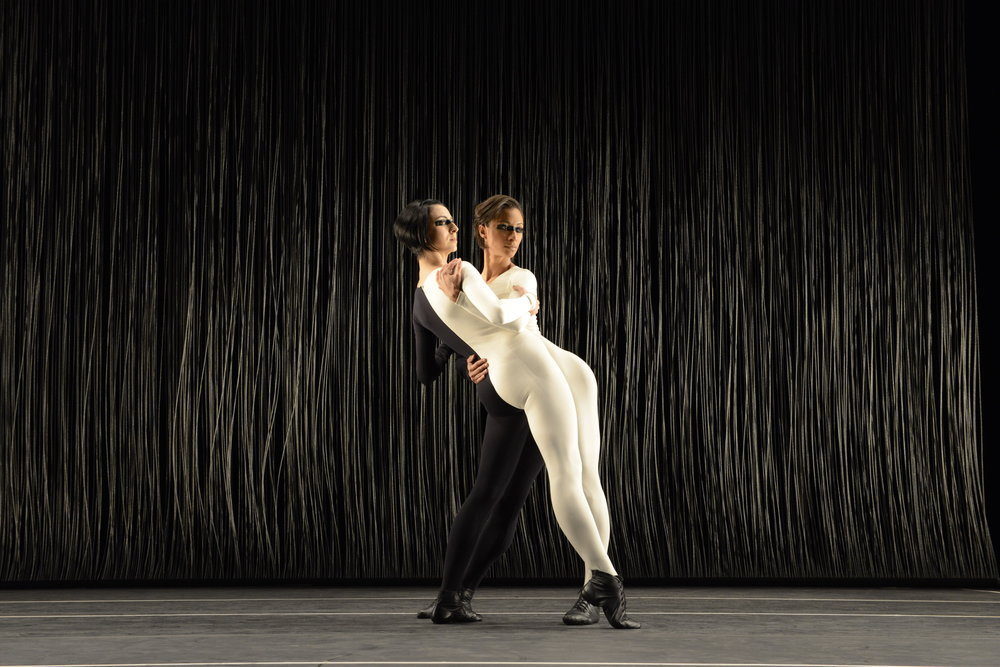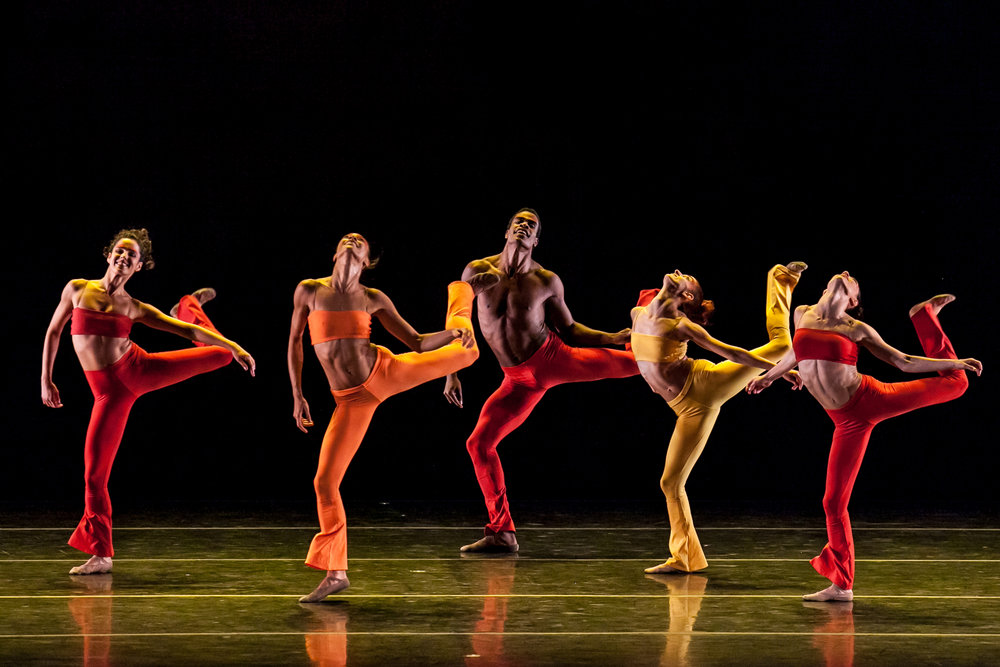Grupo Corpo means Body Group, and if that sounds like the name of a global exercise consortium, it’s because it should be. If I were an entrepreneur media mogul type, I would have shot out of my seat at Sadler’s Wells last night and straight round to the stage door to persuade the Pederneiras siblings who run the company - it's emphatically a family business - that they need to do a fitness video or five, and syndicate an accompanying wordwide branded exercise class guaranteed to have the likes of Zumba and Les Mills, the BodyPump people, quaking in their last year’s Nike Airs.
Grupo Corpo have perfected the dance version of the triathlon, and therefore could do an inestimable service to all the people who hate solitary slogging (it’s rhyming slang), and who, if they’re going to bust a gut burning 500 calories in an hour, would like to do it to an upbeat soundtrack, and with a reasonable chance of cracking a smile. Grupo Corpo’s breathless blend of Zumba, ballet and good old-fashioned 80s dance aerobics would undoubtedly do the trick.
 Seriously though, I have rarely seen a dance group with such impressive stamina. Both the pieces performed at Sadler’s last night, Triz (2013) and Parabelo (1997) come in around the 40 minute mark, and though it’s rare for all the dancers to be on stage at once, the pace is still relentless. The style that choreographic dynast Rodrigo Pederneiras has developed is based on the constant, rhythmic stepping of Latin and ballroom dance, which basically requires (at least) one foot to hit the floor on every beat. To make this interesting, he’s added lots of bouncing, twisting, high kicks and syncopation, which, at speed and combined with the swaying samba hips which mark this out as a specifically Brazilian modern folk idiom, make the dancers work seriously hard. No wonder all 20-odd of them seem to be sporting six-packs. It’s more of a wonder that they were still sporting smiles by the end, but they were, and huge props to them: they deserved the large cheers they got from the crowd.
Seriously though, I have rarely seen a dance group with such impressive stamina. Both the pieces performed at Sadler’s last night, Triz (2013) and Parabelo (1997) come in around the 40 minute mark, and though it’s rare for all the dancers to be on stage at once, the pace is still relentless. The style that choreographic dynast Rodrigo Pederneiras has developed is based on the constant, rhythmic stepping of Latin and ballroom dance, which basically requires (at least) one foot to hit the floor on every beat. To make this interesting, he’s added lots of bouncing, twisting, high kicks and syncopation, which, at speed and combined with the swaying samba hips which mark this out as a specifically Brazilian modern folk idiom, make the dancers work seriously hard. No wonder all 20-odd of them seem to be sporting six-packs. It’s more of a wonder that they were still sporting smiles by the end, but they were, and huge props to them: they deserved the large cheers they got from the crowd.
Whether the pieces themselves deserved such acclaim is another matter. Pederneiras’s ballet-samba-jazz fusion may be smart, quick, and highly polished, but it’s ultimately still genre dance. Nothing wrong with that, of course, but genre dance relies heavily on three things to be interesting: design, soundtrack, and not outstaying its welcome. On all three counts, Triz and Parabelo are at best only partial successes.
Triz has an original score by Lenine based on the many and varied noises of strings – not just bowing, but plucking, hitting, and scraping – interesting, but not exactly pleasant to listen to. The backdrop (designed by Paulo Pederneiras) is made of strings too: thousands of steel wires in a shimmering curtain. With Freusa Zechmeister’s black and white leotards (pictured above right) dividing the dancers’ bodies in half, and the lighting (by Paulo and Gabriel Pederneiras) breaking up the stage into pools of light and shadow, the whole piece has a kind of anxious, jangly, fragmented air. Pederneiras’s choreography is extra twisty and tense, and for about the first eight minutes, the juxtaposition of percussive sound, fragmented visual lines (from the black and white), and jittery, angular movement is quite mesmerising. But it doesn’t change or develop, and the woman-woman duets that introduce some variation land squarely on the dull, slow side of lyrical, so that by the end of its 38-minute running time, all my admiration for dancers and design couldn’t stop me being glad it was over.
 Parabelo has a much warmer colour palette, that gradually lightens from dark to bright. The first half’s red or yellow unitards shot with black, and paired with bright red or yellow jazz shoes give way to black chiffon palazzo pants over coloured leggings, and finally all the black disappears, to leave the dancers doing the finale in eye-poppingly vivid hues of orange, yellow and red (pictured left). Both set (Fernando Velloso and Paulo Pederneiras) and music (Tom Zé and José Miguel Wisnik) evolve too: the one from a backdrop of what looks like an early sculpture of a face, to a family scrapbook photo wall, the other taking in minimal vocals over strings and percussion, and folk-type singing in solos and groups, to end in an upbeat accordion, synth and vocals finale. Though the latter is loads of fun, again it can’t disguise – for me – the stretching of a decent set of ideas into a length (40 minutes) they can’t sustain.
Parabelo has a much warmer colour palette, that gradually lightens from dark to bright. The first half’s red or yellow unitards shot with black, and paired with bright red or yellow jazz shoes give way to black chiffon palazzo pants over coloured leggings, and finally all the black disappears, to leave the dancers doing the finale in eye-poppingly vivid hues of orange, yellow and red (pictured left). Both set (Fernando Velloso and Paulo Pederneiras) and music (Tom Zé and José Miguel Wisnik) evolve too: the one from a backdrop of what looks like an early sculpture of a face, to a family scrapbook photo wall, the other taking in minimal vocals over strings and percussion, and folk-type singing in solos and groups, to end in an upbeat accordion, synth and vocals finale. Though the latter is loads of fun, again it can’t disguise – for me – the stretching of a decent set of ideas into a length (40 minutes) they can’t sustain.
I liked Grupo Corpo, not only for their amazing fitness, and Pederneiras’s accomplished samba-aerobics language, but also for the obvious sincerity and commitment with which they design their pieces and commission new music. And I would happily spend 80 minutes – or more – trying to learn their style in a dance class. But to watch in a theatre, with no chance of joining in, 80 minutes is too long by half.
- Grupo Corpo are at Sadler's Wells until 4 October, then touring to eight more UK venues (including Birmingham, Edinburgh and Belfast) until 5 November.














Add comment